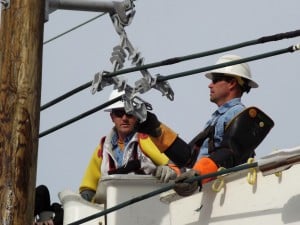U.S. Seen as Biggest Oil Producer After Overtaking Saudi Arabia
By Grant Smith Jul 4, 2014 11:56 AM ET
The U.S. will remain the world’s biggest oil producer this year after overtaking Saudi Arabia and Russia as extraction of energy from shale rock spurs the nation’s economic recovery, Bank of America Corp. said.
U.S. production of crude oil, along with liquids separated from natural gas, surpassed all other countries this year with daily output exceeding 11 million barrels in the first quarter, the bank said in a report today. The country became the world’s largest natural gas producer in 2010. The International Energy Agency said in June that the U.S. was the biggest producer of oil and natural gas liquids.
“The U.S. increase in supply is a very meaningful chunk of oil,” Francisco Blanch, the bank’s head of commodities research, said by phone from New York. “The shale boom is playing a key role in the U.S. recovery. If the U.S. didn’t have this energy supply, prices at the pump would be completely unaffordable.”
Oil extraction is soaring at shale formations in Texas and North Dakota as companies split rocks using high-pressure liquid, a process known as hydraulic fracturing, or fracking. The surge in supply combined with restrictions on exporting crude is curbing the price of West Texas Intermediate, America’s oil benchmark. The U.S., the world’s largest oil consumer, still imported an average of 7.5 million barrels a day of crude in April, according to the Department of Energy’s statistical arm.
https://www.bloomberg.com/news/2014-07-04/u-s-seen-as-biggest-oil-producer-after-overtaking-saudi.html
Tag: energy
U.S. electricity prices may be going up for good
file photo by Boyd Loving
U.S. electricity prices may be going up for good
Experts warn of a growing fragility as coal-fired plants are shut down, nuclear power is reduced and consumers switch to renewable energy.
By Ralph Vartabedian
April 25, 2014, 8:47 p.m.
As temperatures plunged to 16 below zero in Chicago in early January and set record lows across the eastern U.S., electrical system managers implored the public to turn off stoves, dryers and even lights or risk blackouts.
A fifth of all power-generating capacity in a grid serving 60 million people went suddenly offline, as coal piles froze, sensitive electrical equipment went haywire and utility operators had trouble finding enough natural gas to keep power plants running. The wholesale price of electricity skyrocketed to nearly $2 per kilowatt hour, more than 40 times the normal rate. The price hikes cascaded quickly down to consumers. Robert Thompson, who lives in the suburbs of Allentown, Pa., got a $1,250 bill for January.
“I thought, how am I going to pay this?” he recalled. “This was going to put us in the poorhouse.”
The bill was reduced to about $750 after Thompson complained, but Susan Martucci, a part-time administrative assistant in Allentown, got no relief on her $654 charge. “It was ridiculous,” she said.
https://www.latimes.com/nation/la-na-power-prices-20140426,0,6329274.story#ixzz304sGYz00
Keystone XL’s continued delay is absurd
Keystone XL’s continued delay is absurd
By Editorial Board, Published: April 23
IF FOOT-DRAGGING were a competitive sport, President Obama and his administration would be world champions for their performance in delaying the approval of the Keystone XL pipeline.
Last Friday afternoon, the time when officials make announcements they hope no one will notice, the State Department declared that it is putting off a decision on Keystone XL indefinitely — or at least, it seems, well past November’s midterm elections. This time, the excuse is litigation in Nebraska over the proposed route, because that might lead to a change in the project that various federal agencies will want to consider. The State Department might even decide to substantially restart the environmental review process . This is yet another laughable reason to delay a project that the federal government has been scrutinizing for more than five years.
At this point, there is little doubt about the big picture. After two thorough environmental analyses, State Department experts determined that the pipeline’s impact probably would be minimal, even on climate change-inducing carbon dioxide emissions. The economic rewards of extracting Canadian oil are too attractive and the options for getting it out of the countryare too numerous. We would rather see Canadian crude traveling a well-built, well-regulated pipeline in the United States than on the rail cars, barges and ocean tankers that will move it until cheaper options inevitably come online.
That does not mean we like burning dirty oil sands crude. But symbolic gestures will have no impact on climate change. Governments should steadily reduce global carbon dioxide emissions with smart, economy-wide policies such as carbon taxes, which meaningfully and permanently cut demand for carbon-heavy fuels. Alberta’s provincial government, which oversees much of Canada’s oil development, is considering enhancements to its fairly weak carbon price system, which could redress some of the excess emissions associated with pulling the viscous oil out of the ground.
If activists want to make a real difference on carbon dioxide emissions, they should devote their energies to establishing an ambitious carbon price across Canada and in the United States — or, if that’s not achievable, any number of second-best but serious policy options. In a comprehensive and efficient system, it might well make economic sense to burn some Canadian crude for quite a while as the world slowly transitions away.
As for the pipeline’s routing, planners and regulators have already considered all sorts of options through Nebraska, and they already shifted the route once. Neither route posed environmental concerns of a sort that would justify concluding that Keystone XL is outside the national interest. It is bizarre to imagine that a new route from an even more careful process in Nebraska would significantly increase environmental concerns.
The administration’s latest decision is not responsible; it is embarrassing. The United States continues to insult its Canadian allies by holding up what should have been a routine permitting decision amid a funhouse-mirror environmental debate that got way out of hand. The president should end this national psychodrama now, bow to reason, approve the pipeline and go do something more productive for the climate.
https://www.washingtonpost.com/opinions/keystone-xls-continued-delay-is-absurd/2014/04/23/81dab79c-c98c-11e3-95f7-7ecdde72d2ea_print.html
‘Ridiculous’: Administration punts on Keystone, Obama faces Dem revolt
‘Ridiculous’: Administration punts on Keystone, Obama faces Dem revolt
The Obama administration once again has punted on a final decision for the Keystone XL pipeline, announcing ahead of the holiday weekend it is extending a key review period indefinitely — a move that could push off a determination until after the midterm elections.
Republicans, as well as red-state Democrats who want the proposed Canada-to-Texas pipeline approved, slammed the administration for the delay. Democrats even threatened to find ways to go around the president to get the project approved.
“It’s absolutely ridiculous that this well over five year long process is continuing for an undetermined amount of time,” Sen. Heidi Heitkamp, D-N.D., said in a statement.
Republican Nebraska Rep. Lee Terry called the decision “shameful,” noting that another spring construction season will come and go without the project.
The administration had been in the middle of a 90-day review period for federal agencies assessing an environmental study from the State Department.
But the State Department said Friday it is giving agencies “additional time” to weigh in, in part because of ongoing litigation before the Nebraska Supreme Court which could affect the pipeline’s route. If the route changes, officials made clear the State Department reserves the right to conduct another environmental impact study to include more public comments, which could delay the process more.
https://www.foxnews.com/politics/2014/04/18/obama-administration-extends-review-period-for-keystone-xl-oil-pipeline/
North Jersey towns unite in effort to lower utility bills
North Jersey towns unite in effort to lower utility bills
SUNDAY JANUARY 19, 2014, 12:44 AM
BY DAVE SHEINGOLD
STAFF WRITER
THE RECORD
A growing contingent of North Jersey municipalities is looking to use the power in numbers to cut residents’ utility bills through large-scale purchasing programs that promise better electricity prices.
At least 15 municipalities in the region are at various stages of adopting the programs, which advocates say allow them to pool the buying power of residents as a way of lowering their bills.
Residents in municipalities that approve the programs are automatically enrolled and must notify their borough or city halls if they want to withdraw and stay with traditional utility companies like Public Service Electric and Gas or Jersey Central Power & Light.
Officials say the programs promise to save the average homeowner $80 to $120 over a year’s time.
The programs use a 2003 state law that lets municipalities effectively take over energy purchasing for residents when market conditions are favorable. Local officials started pursuing the law last year when energy-price trends began working for the idea after years when they did not.
“The impetus behind it is to try to find a way to save residents, as well as businesses, money. It’s power in numbers,” said Michael Capobianco, borough manager in Little Ferry, the first municipality in Bergen and Passaic counties to seek bids from energy suppliers. Borough residents are expected to start getting lower-priced power this year.
“If we can take 10 percent off someone’s energy bill over the course of a year, it’s fantastic,” Capobianco said.
– See more at: https://www.northjersey.com/news/North_Jersey_towns_unite_in_effort_to_lower_utility_bills.html#sthash.7cGS71Zo.dpuf
State seeks to cut back ambitious energy reduction goals
State seeks to cut back ambitious energy reduction goals
Say adieu to the state’s aggressive goal of reducing energy use by 20 percent by 2020, a target once considered crucial to achieving equally ambitious goals in curbing greenhouse gas emissions.
The state expects to achieve far fewer reductions in energy use — at least in the short-term — from consumers and businesses as a result of changes it is proposing to its clean energy program.
In a straw proposal outlining its spending plans from 2014-2017, the state Office of Clean Energy estimates it will cut energy consumption by 17 percent by 2020, a 3 percent decline from an earlier goal in the Energy Master Plan adopted by the Corzine administration. (Johnson, NJ Spotlight)
Pilot Plan to deploy CNG refueling stations for compressed natural gas
Pilot Plan to deploy refueling stations for compressed natural gas
In a step that reflects a goal of the state Energy Master Plan, regulatory officials yesterday approved a pilot program to allow a utility to spend up to $10 million to build compressed natural gas (CNG) refueling stations in its service territory.
The state Board of Public Utilities approved the one-year pilot proposed by New Jersey Natural Gas to build between five and seven CNG refueling stations at companies that plan to convert a portion of their fleets to run on the fuel, as well as provide opportunities for the public to fill up their natural gas vehicles. (Johnson, NJ Spotlight)
https://www.njspotlight.com/
State faces triple energy challenge in New Year
>
New Energy Master Plan explores ways to deploy infrastructure for alternative works
>New Energy Master Plan explores ways to deploy infrastructure for alternative works
Democrats close ranks to review administration’s proposed energy policy,kill jobs
>Democrats close ranks to review administration’s proposed energy policy, kill jobs
Revamped Energy Master Plan casts shadow on solar
>
Revamped Energy Master Plan casts shadow on solar
![]()








